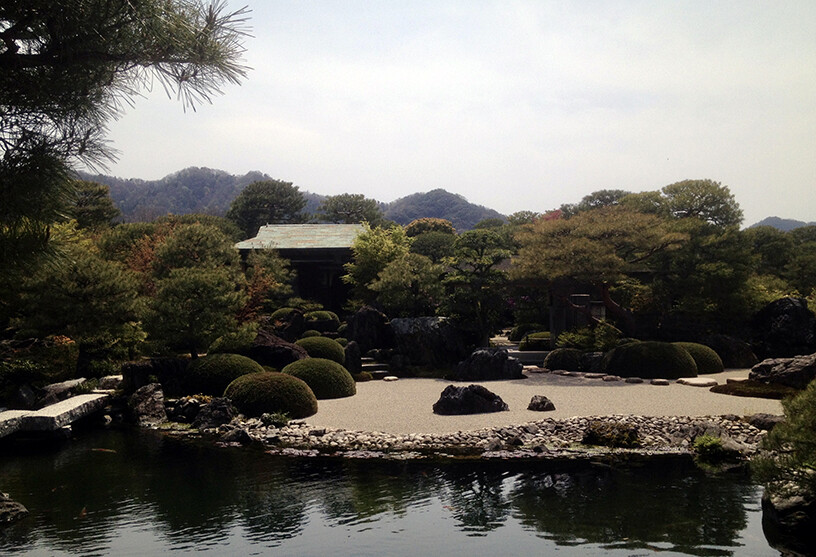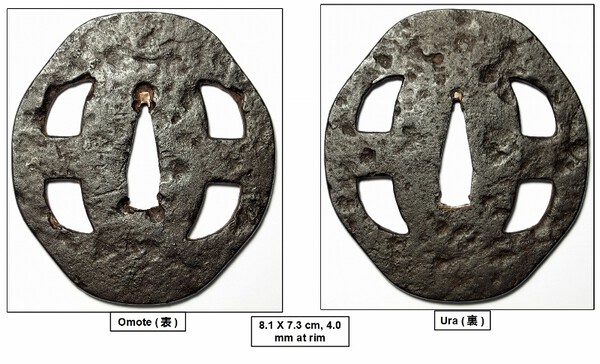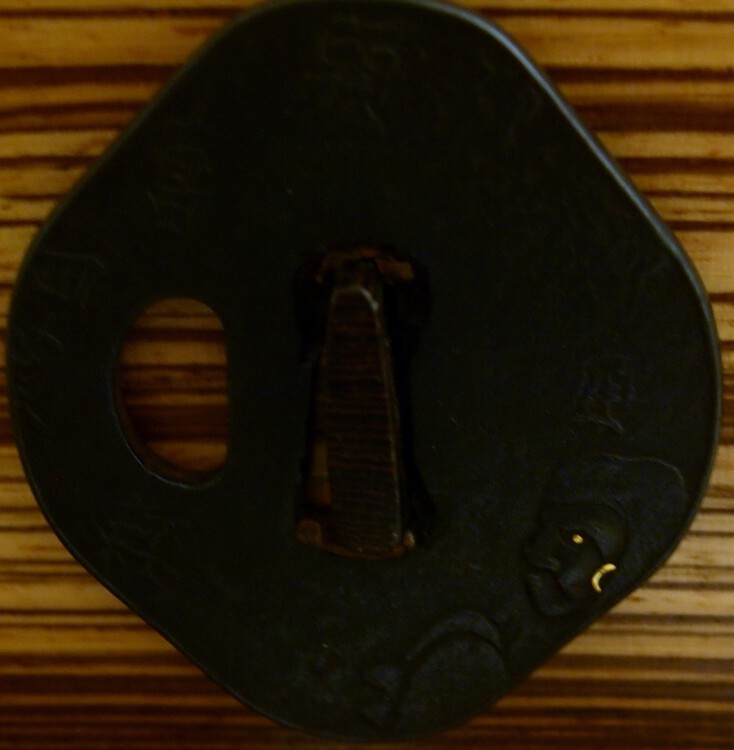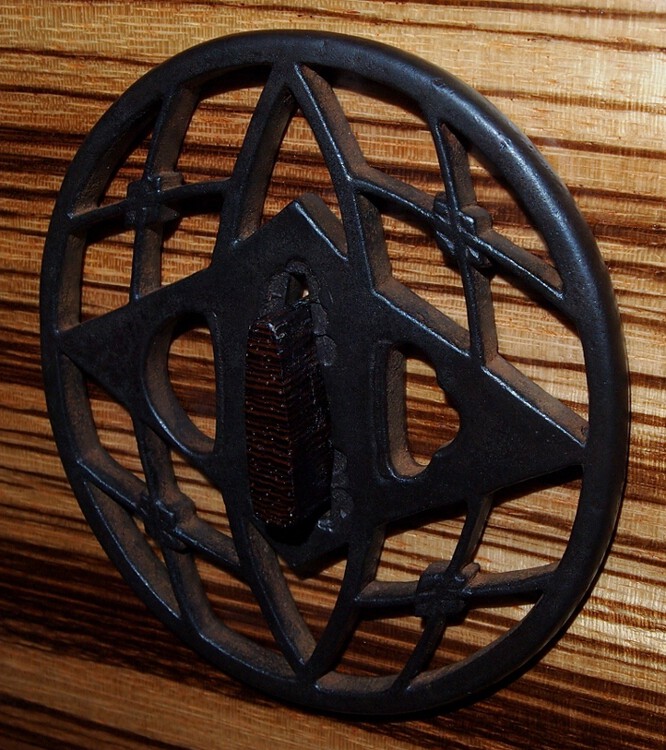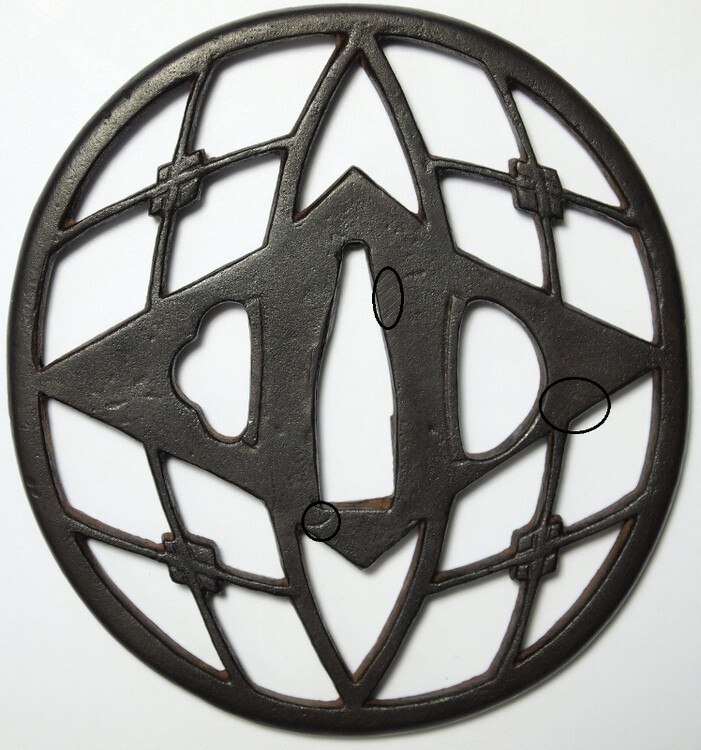-
Posts
2,901 -
Joined
-
Last visited
-
Days Won
3
Content Type
Profiles
Forums
Events
Store
Downloads
Gallery
Everything posted by Soshin
-
Hi Pete, Thanks for the correction. I did not check the NBTHK website before posting to the tread. I hope in the not too distant fulture to be submitting something to the Juyo shinsa. Yours truly, David Stiles
-
Hi Henry, This is the only tsuba in my collection right now that has ever received the label of Katchushi tsuba. The color of my tsuba is very different. Yours have more of a brownish-black color while mine has more of a plain dark black color. I think the plate was cleaned of all rust by the previous owner above what I would have done but I still like the design and feel of the iron. I would also like to echo Christian and Pete's call that your "katchushi" tsuba in question would be a good candidate for shinsa specifically NBTHK shinsa as you live in Tokyo and would be very easy to submit. There is a shinsa coming up in August that has a tsuba of mine with the same kamon design as your tsuba. I think my tsuba will paper hozon to Edo Period, Owari Sukashi. This is just my opinion. Yours truly, David Stiles
-
Hi Henry, Here is the tsuba. I was able to take some good photos before getting sick this past weekend. The measurements for my unknown but old tsuba are 7.2 cm X 7.0 cm, 2.8 mm seppa-dai, 2.0 mm at rim. I think it is old based upon how the design is done, thinness of the plate, and shape of the kozuka hitsu-ana. Below is a write up I did about the design of the tsuba. Here are my comments about the iron: Enjoy. Comments and questions welcome. Yours truly, David Stiles
-
Hi Henry, That is a really nice tsuba you have. :D It like another tsuba in collection has many indications that it is old (pre Edo Period) but does not fit well into any category. Would it be alright to post it on this topic as a former owner was thinking it was a early Katchushi tsuba circa the Muromachi Period? Another well respected collector was thinking it is a Ko-Shoami tsuba. It might take me a few days to post it as I am fighting off a bad cold right now. Take care. P.S. There is the scan of page 31 from the book Pete K. referenced in his post. Yours truly, David Stiles
-
Hi Jean C., I think what your were shown is the visible wear caused by the placement of the thumb on the edge of the rim of the tsuba. I have never seen results of knuckles rubbing on the sukashi of a tsuba. Yours truly, David Stiles
-
Hi Everyone, I updated the topic with the transliteration I did of the tsuba examination paper. Here is a short summary of the papers translation read from right to left top to bottom. Front Cover: 1. Name of paper and level of worthiness: Kanteisho, This is awarded to fittings that are worthy of preservation and are of good quality. 2. The item: Tsuba (鍔) 3. Attribution: Saga Tsubako Saku (佐賀鍔工) - Made by a Tsuba craftsman in Saga. 4. This item is: Shoshin (正真) - Genuine 5. The date: Heisei Ni Ju Yo Nen Ni Gatsu Ju Toka - 10th of February, 2012 6. Signed and sealed: Nihon Token Hozon Kai (日本刀剣保存会) Inside: 7: The licence number: 5881 8: Signature: Meibun Mumei (銘文 無銘) Without Signature 9. Work Style: Goishi gata (碁石形) - Go game piece shape, Kata hitsuana (片櫃孔) - a Hitsu ana on one side, Kakumimi Koniku (角耳小肉) - a squared rim that is slightly rounded, Shitaji (下地) - ground material tetsu (鉄) - Iron, tsuchime-ji (槌目地) - hammer marks on surface. 10. Zugara (図柄) - motif Daruma (達磨) - Buddhist monk Bodhidharma. Hori (彫瘢雹り) - carving style - Sukidashibori (鋤だし彫リ) - craving style, kinzogon (金象嵌) - gold inlay. 11. Other remarks: Biko (備考) - remarks : Edo koki (江戸後期) - late Edo period. Thanks for reading. Yours truly, David Stiles
-
Hi Everyone, Here are the scans of the NTHK shinsa origami I recivied in the mail on Friday. The tsuba attribution is to a tsuba maker in the city of Saga, Hizen Province located on the southern island of Kyushu. I am still in the process of translating everything. I will post what I come up with in a few days. Enjoy and thanks for viewing. Yours truly, David Stiles
-
Hi Mariusz K., I think Pete is correct on this point about the tapering being not a mandatory kantei point for Ko-Tosho tsuba. Have and had some Ko-Tosho with the tapering toward the rim, no tapering, and some times tapering towards the seppa-dai. Often you do see tapering towards the rim in later Tosho tsuba fairly consistently. This just my opinion form observing a fair number of Tosho tsuba in hand. Hi Henry W., I love your last photograph of your kantei tsuba. What a wonderful tsuba box. I have only see a few really nice boxes like this before. Are they easier to find in Japan? Yours truly, David Stiles
-
Hi Christian, The nade-mokko gata shape reminds me of many O-Shodai works as well as the abstract sukashi design. As I have never seen a O-Shodai work in hand or have detail photos of it is hard to compare the finer details of the iron. With this said the tsuba is likely a nice Ko-dai Yamakichibei work by someone during or after the time of Yondai Yamakichibei. Yours truly, David Stiles
-
Hi Everyone, I am currently in the process of working on a write up about a new tsuba I have added to my collection with a unknown ko-sukashi design. I would like to hear other peoples opinions on the design. I think it could be a stylized wheel (kuruma) design or a cross (ju-ji) but I am not sure. To me design looks very bold with added strength of the iron texture caused by the hammer marks (tsuchimei-ji) and heat treatment (yakite shitate). The patina in a wonderful purplish black color. Notice what I think is a very old repair on the ura side at 3:00. Thanks in advance for viewing my topic and offering your opinion or general comments. Yours truly, David Stiles
-
Hi Henry, I think it is a early Tosho tsuba example circa late Muromachi Period or Momoyama Period using the NBTHK terminology for what is or isn't a Ko-Tosho tsuba. Thanks again for starting this topic. Yours truly, David Stiles
-
Hi Henry, Thank you for the information. I find this most interesting. I will need to do some research and reply a little latter. Yours truly, David Stiles
-
Hi Henry, Quick but important question. What is the thickness of the tsuba at the seppa-dai and the mimi? Does the thickness increase from the mimi to the seppa-dai for example? Thank you taking the time to answer my question. Once I have my answer I will offer a educated guess about the tsuba. Yours truly, David Stiles
-
Hi Grev, I like the last tsuba. The others are low end and/or in fairly poor shape. This is just my opinion. Many of the tsuba likely date from the Meiji Period or later. Number nine from the top strangely looks unfinished or a really poor copy of a Echizen Kinai dragon motif tsuba. Yours truly, David Stiles
-
Here are some photos of a new possible Yagyu tsuba to my collection that I think was made by the Ono school of Owari. The overall size is 6.8 X 6.6 cm the rim thickness is 5.0 mm. The design is of a shrine gate and fence. The original owner was thinking it was a work of the Ono school from Owari and a possible Yagyu tsuba. The rim shows many lamination folds and a few tekkotsu. The patina color is a wonderful deep glossily blackish-brown color. I really like the design of this little tsuba. At some point in the future I would like to submit it for shinsa. Let me know if photos of the rim would be helpful. Feel free to comment and ask any questions. Yours truly, David Stiles
-
Hi Jean C. and Brian, I love tsuba that you keep looking at and see more and more things in the details. Jean C. you could be right about snow on the tops of the bamboo leaves on the ura side of the tsuba. Here is a photo taken last night. It nicely shows the contrast between the bright gold inlays of the eye and earring and the dark black patina of the iron on the omote side. Currently the shinsa paper are in transit from Japan to the USA. I will post a reply with a update once have the paper and do a translation. Yours truly, David Stiles
-
Hi Rich, You very correct about this. I am not buying anything new until next year at the Tampa show and will save my money. Thank you for taking the time to reply and for clarification. I am not good paraphrasing others comments. I am going to stop doing this. I agree the tsuba was likely in poor condition an repatinated and saved from a rusty death by Skip. With this said if I keep it in my collection It will not be going to shinsa. Do you think the workmanship is consistent with late Kamiyoshi school work or a Akasaka copy circa mid Edo Period? Thanks again for the time and effort you put in to teaching me from afar. Yours truly, David Stiles
-
Hi Henry, It something about Daruma's expression on this tusba I just love. :D The bamboo and clouds on the reverse side is also very "Zen" in my honest opinion. The NTHK shinsa team was also friendly and happy to answer the questions I had about the authentication, identification, and attribution process. But they were not able to read all of the Kanji on tsuba many which are not readable as they are no longer in general use in Japan. Yours truly, David Stiles
-
Hi Everyone, This is a topic about a tsuba that I am 100% sure it is not a cast copy! :lol: I received notice about my NTHK Kanteisho for a tsuba I submitted at the Tampa NTHK Shinsa in February of this year. NTHK liked the tsuba and awarded it a 70 point score and the higher Kanteisho paper. The lower paper is referred to as a Shintesho for nihonto and tosogu scored between 60-69. I have recently rephotographed the tsuba using my new digital camera Olympus Pen E-PL1 . Once I get the paper I will scan photos for everyone to see. I will also do a translation of the Kanteisho and post it along with scans. I always find this process informative and worth the time effort. Feedback and comments are welcome. P.S. The tsuba was discussed here before:http://www.militaria.co.za/nmb/viewtopic.php?f=2&t=12243. Yours truly, David Stiles
-
Hi Henry, Thanks for the reply and the help. I do remember my tsuba having a glossiness to its surface. The overall color of the patina I would refer to as brownish black as well. It is reflected better in the higher resolution photos I posted later I think. I also noticed some features in my tsuba that are not on the tsuba in the book. I upload a edited photo where the features are highlighted with black circles. This still does not explain the ryo hitsu-ana being iron issue. I still don't know about this tsuba. Yours truly, David Stiles
-
Hi Mike Y., I am not familiar with Higo tsuba in general more less Hayashi or high-end Kamiyoshi tsuba. What does the term "yokan tetsu" refer to in regards to the iron? Having some Kanji would be helpful. As a fellow member of the America Branch of NBTHK could you take a look my tsuba which is topic of this discussion? It will be at Grey Doffin's table as I will be unable to attend the upcoming San Francisco show this year. If you are around at the next Florida show I will take a look at your tsuba for future reference. Thank you very much for any help you can provide and explaned my general understanding of Higo tsuba. Yours truly, David Stiles
-
Hi Michael, Nice to hear from you. I was doing some reading as I don't know much about Higo tsuba. In Tsuba An Estetic Study it says the 2nd generation Hayashi Shigemitsu was well know for using a round tangane to finsh around the outside of the nakago-ana. As for the patina it doesn't look or smell like it was recently repatinated. Patina color would be consistent with your idea that it is the work of later generation Kamiyoshi Higo school. As well as the fake inserts which would keep with the estestics of the Hayashi or Kamiyoshi schools. Thank you Grey for your valid in hand observations of the tsuba. I was thinking my tsuba was not cast copy of the tsuba in Ito's book. As of now I am really unsure and will wait until after the SF sword show to make a final judgement. Yours truly, David Stiles
-
Hi Colin, I will be taking into consideration Brian, Ford, Lorenzo, and others comments in consideration when I make a final judgement to keep the tsuba. I would also like to have some knownledgable people examine the tsuba it in person. Yours truly, David Stiles
-
Dear Everyone, I would agree with Grey. I want to get to the bottom of mystery about this tsuba. If it is a cast reproduction then it is at such a high quality level I have haven't seen before. I would say much better then the cast reproductions coming out of modern Japan that you often seen on iaito practice swords. As well as being miles away from the fake Chinese reproductions. Yours truly, David Stiles

